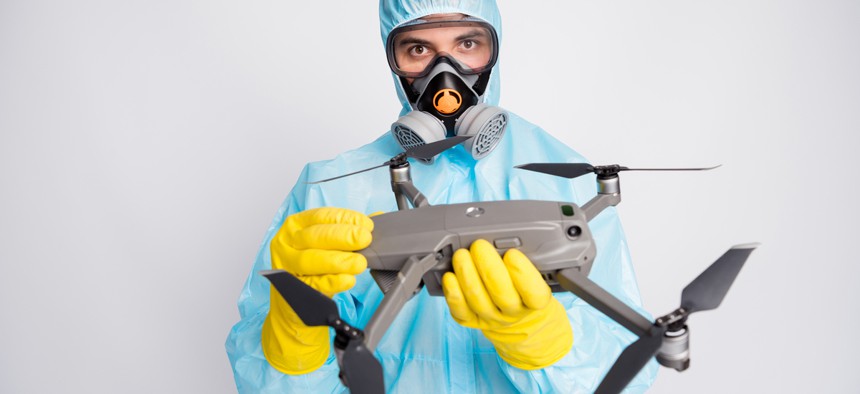Can Robots and Drones Help to Fight COVID-19?

Roman Samborskyi/Shutterstock.com
Using drones to help make our living and working spaces a little safer is not too much of a stretch.
It’s great news that people are finally starting to get vaccinated against the COVID-19 virus. I hope that the current rollout problems get worked out soon so that everyone can get access to this potentially life-saving vaccine. But we also need to temper our excitement some, because it will be a long time before things get back to normal, if they ever do. A recent National Geographic article makes the case that we will never fully defeat COVID-19, just like we never conquered the flu. And the virus is also mutating and continuing to spread, making its full destruction a moving target. Instead, the best we may achieve is to get the situation somewhat under control, and then learn to live with it.
It’s no surprise that learning to live with the virus in the United States will likely mean getting our amazing technology involved. As such, there is a big push to use drones and other manned and unmanned aerial vehicles to help combat infection rates. We have already seen drones working within the military and also embraced in public safety roles. And we have tapped them for planetary and space exploration. So using drones to help make our living and working spaces a little safer is not too much of a stretch.
In government, we are already starting to see some movement on these initiatives even though the idea of using drones to fight COVID-19 is still in its infancy. In Alabama, the state senate recently contracted with a company called Draganfly to use its robotics technology to detect potentially infected people entering government buildings and direct them to rapid COVID-19 testing if needed.
“As the current pandemic continues, we are committed to provide a safe place for our staff and visitors to ensure there is no interruption in the work that needs to be done for the citizens of Alabama,” said Pat Harris, Secretary, Alabama State Senate. “We are confident that the implementation of Draganfly’s Vital Intelligence Technology will help to ensure an important layer to existing protocols that assist us in identifying and mitigating the risk of the spread of COVID-19.”
In addition to monitoring people for signs of infection, the Draganfly drones can actively disinfect areas by flying over them and spraying a disinfectant. It’s been used at stadiums and other large venues to sterilize the area before an event.
Other companies are working on dedicated COVID-19 killing drones. Lucid Drone Technologies has one that includes an expanded battery for longer flight times. It’s able to clean 200,000 square feet per hour, which is at least 20 times faster than having a human walk around trying to wipe everything down. It’s probably a lot more accurate too, because the special nozzles guarantee even coverage over every surface.
Other companies are working on different disinfecting methods, such as using UV radiation to destroy the virus in indoor places like schools where spraying large amounts of liquid is not practical. The Aertos 120-UVC drone from Digital Aerolus has several UV-C light emitters that would give a human a nasty sunburn in just a few minutes, but hopefully would also be enough to kill the COVID-19 virus. With so many electronics onboard the Aertos drone, it’s no wonder that it only has about 10 minutes of flight time, though multiple units could be used to sterilize schools at night when nobody else was in the building. A human crew could also swap out batteries if needed.
While I am impressed with the virus-killing drones we have seen so far, the technology is still being actively developed. All of the drones that I have seen designed for this role so far require human pilots. So although they might save time compared with walking along with a bucket of chemicals and a squeegee, it’s far from an automatic process.
Advanced military drones already have access to a lot of artificial intelligence. It would not take too much effort to add some of those elements to civilian cleaning robots. Things like automatic navigation, pathfinding and the ability for the drone to remember its programmed route would be like force multipliers for a sterilization drone. You would probably also need to add sensors so that the drone can detect humans inside their cleaning zone to make sure that nobody gets accidentally sprayed, or burnt in the case of the UV light drones.
But this is a good start to an impressive effort. I’ve tried to get a hold of one of the sterilization drones for review, but so far the companies that make them tell me that every one of their drones are earmarked and sold at least through the end of the year. So it sounds like everyone should start seeing drones in this role soon. Let’s hope that they can make a difference as we try to figure out what normal life is going to look like and continue to discover ways to keep everyone as safe as possible.
John Breeden II is an award-winning journalist and reviewer with over 20 years of experience covering technology. He is the CEO of the Tech Writers Bureau, a group that creates technological thought leadership content for organizations of all sizes. Twitter: @LabGuys






